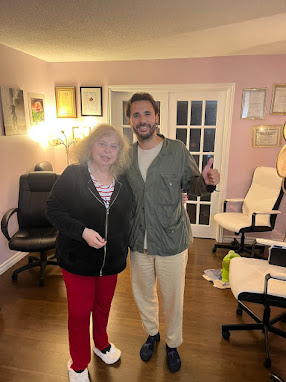How To Master Your Speaking And Singing Voice… Scientifically Speaking!
Spending
over 32 years running my own professional voice/vocal business, I have been
working with (estimated) over 20,000 clients on their speaking and singing
voices. Luckily,
the mechanics (which are applicable for the speaking and singing voice) are
exactly the same.
Both
my speech (The Total Communicator Course) and singing course begin with exactly
the same speech exercises. Those exercises have a very important purpose, as
they are designed to relieve the pressure of the sound from the vocal anatomy
as a whole.
The
wholesome mechanism takes place to allow the voice to work in the fullest
capacity possible with no pain or strain on the vocal anatomy. The voice,
restructured to the facial muscles, begins to work in full conjunction and coordination
with the abdominal muscles, which play the role of the support for the lifted
sound. And the upper diaphragm muscles (rib cage) assure the width and the body
of the sound.
When
all of the components of that wholesome mechanism begin work simultaneously,
the voice then becomes supported, structured, placed and projected to its aimed
destination. The speaking voice begins to sound clearly enunciated and
projected.
The
latter is good preparation for embarking upon the singing voice development.
Utilizing the same mechanics as for the speaking voice, now it is the time to
address the musical side of it.
In
this case, the singer-to-be represents the “Instrument” and the “player” at once.
The physical body and its emotional makeup would represent the “instrument”. The
proper application of the speaking and singing voice will represent the
“player”. If the “instrument” is in good physical and emotional balance, the
voice (which will be bouncing off of it) will sound that much better. The
future singer should know the parameters of his/her “instrument” to be able to
apply the sound above the physical anatomy (an out-of-body experience, so to
speak…)
Therefore,
needless to say, before attempting to sing any song, the music analysis of the
chosen song should be applied. Any song consists of certain combinations of
sounds, duration and pitch, (i.e., intervals). During the singing exercises,
all possible combinations of sounds, duration and pitch, should be addressed.
Also, the situations where those combinations may exist will also have to be addressed.
With
that said, once you are aware of all of the combinations and all of the
situations (where those combinations may and will exist), you will become the
owner of your voice. (Speaking and Singing).
---------
Diana Yampolsky is the Master Vocal Coach, Studio Vocal Producer, and Non-Surgical Voice Repair Specialist at The Royans Professional Vocal School and The Royans Institute for Non-Surgical Voice Repair, in Toronto, Canada and worldwide. She is the sole creator of the Vocal Science (TM) method - Trademarked with the Government of Canada.
If you find yourself struggling with voice/vocal performance or are in need of non-surgical voice repair, you can reach Diana Yampolsky personally via email (info@vocalscience.com) or phone, (416-857-8741)



